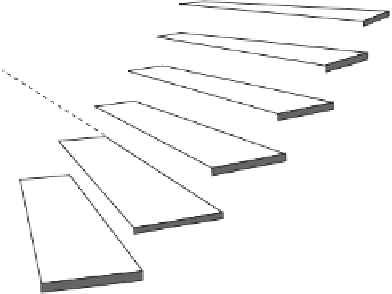Graphics Programs Reference
In-Depth Information
Figure 3.7: Many Vanishing Points.
We therefore conclude that an object seen in perspective can have any number of
vanishing points, even zero. In addition, the number and positions of those points vary
when the object is moved or changes its orientation and when the viewer moves, turns,
bends, tilts his head, or cranes his neck. The rule governing the number and position of
the vanishing points is simple and can be considered the main principle of perspective.
Before this rule is stated, let's take another look at Figure 3.5d. It features two vanishing
points, each created by a group of parallel lines. The point is that originally (i.e., in
Figure 3.5b) these lines seem parallel, but when the viewer moves to a different location,
looking at the same object from a different direction, these same lines no longer look
parallel and seem to converge.
*
*
*
*
*
*
*
*
(a)
(b)
Figure 3.8: Effects of a Small Rotation.
Figure 3.8 serves to further illustrate the behavior of the vanishing points. Part (a)
of the figure shows the cube of Figure 3.5b with the four parallel edges marked with
an asterisk. In part (b), the cube is rotated through a small angle, which slightly
changes the orientation of these four edges relative to the viewer.
They no longer




Search WWH ::

Custom Search